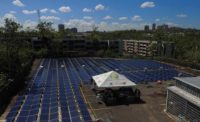Entergy reported Aug. 31 it has determined two ways to get power to the New Orleans metropolitan region following Hurricane Ida, which took out all transmission lines that feed power to the region. More than 800,000 people in the region were without power on Aug. 31, although the utility had begun restoring it.
New Orleans City Council Member Helena Moreno released Entergy's comments on Facebook, in which the utility said one option would be to restore some of the eight transmission lines that tie New Orleans and its suburbs to the nation’s electric grid. That is the utility’s preferred option.
It could also create a mini electrical grid by not reconnecting to the larger grid and instead using generation from the 128-MW New Orleans Power Station east of the city’s core, and from the 560-MW Ninemile 6 plant, across the Mississippi River in Westwego, La., to power the city. Both are relatively new natural gas power plants.
[Read more about Hurricane Ida's impacts throughout Louisiana here]
Entergy did not provide a timeline, but it has begun repairing some distribution lines around the area. Restoration will begin with restoring power to hospitals—which have been running on generators—nursing homes and and first responders, according to the utility. Then, restoration will vary by parish and neighborhood based on local transmission and distribution damage.
Questions have been raised why the New Orleans Power Station, which opened in 2020, had not been used earlier.
When the controversial natural gas plant was approved, Entergy touted that it has self-start capability, which allows the company to start the unit even when there is no power on the electric grid, and that the plant would help with storm restoration. Responding to a question about that claim, New Orleans Mayor LaToya Cantrell said at an Aug. 31 press briefing, “I have to make sure that Entergy is held accountable every step of the way,” but that she is primarily focused on getting power back to the city.
Mississippi Road Failure Kills Two
Related to other Ida impacts, it is believed that the hurricane’s heavy rains may have contributed to the collapse of a southeast Mississippi highway that killed two motorists and injured nearly a dozen others.
According to the state Highway Patrol, the washout appeared apparently without warning overnight Aug. 31 on two-lane State Route 26 in a rural area approximately 60 miles northeast of Biloxi. Multiple vehicles fell into the depression, which officials estimated to be 50 to 60 ft long and 20 to 30 ft deep.
[View video of the washed out section of roadway here]
Although an investigation into the collapse is in its early stages, National Weather Service data indicate the area received 8 in. of rainfall as Ida passed through.
Also, in an MSNBC televised interview, Joe Valiente, director of emergency management for Jefferson Parish, called the living conditions in the town of LaFouche and in upper parish areas “virtually unbearable” as the temperature rises and “critical infrastructure has been destroyed.” He said there is no clean water, power, cell service, or food supplies available. Valiente said a large part of the population did not evacuate, and officials are advising residents to seek shelter out of state. He also said 3 to 6 ft of sand washed up into Grand Isle, a coastal barrier island, which he called "uninhabitable."






Post a comment to this article
Report Abusive Comment